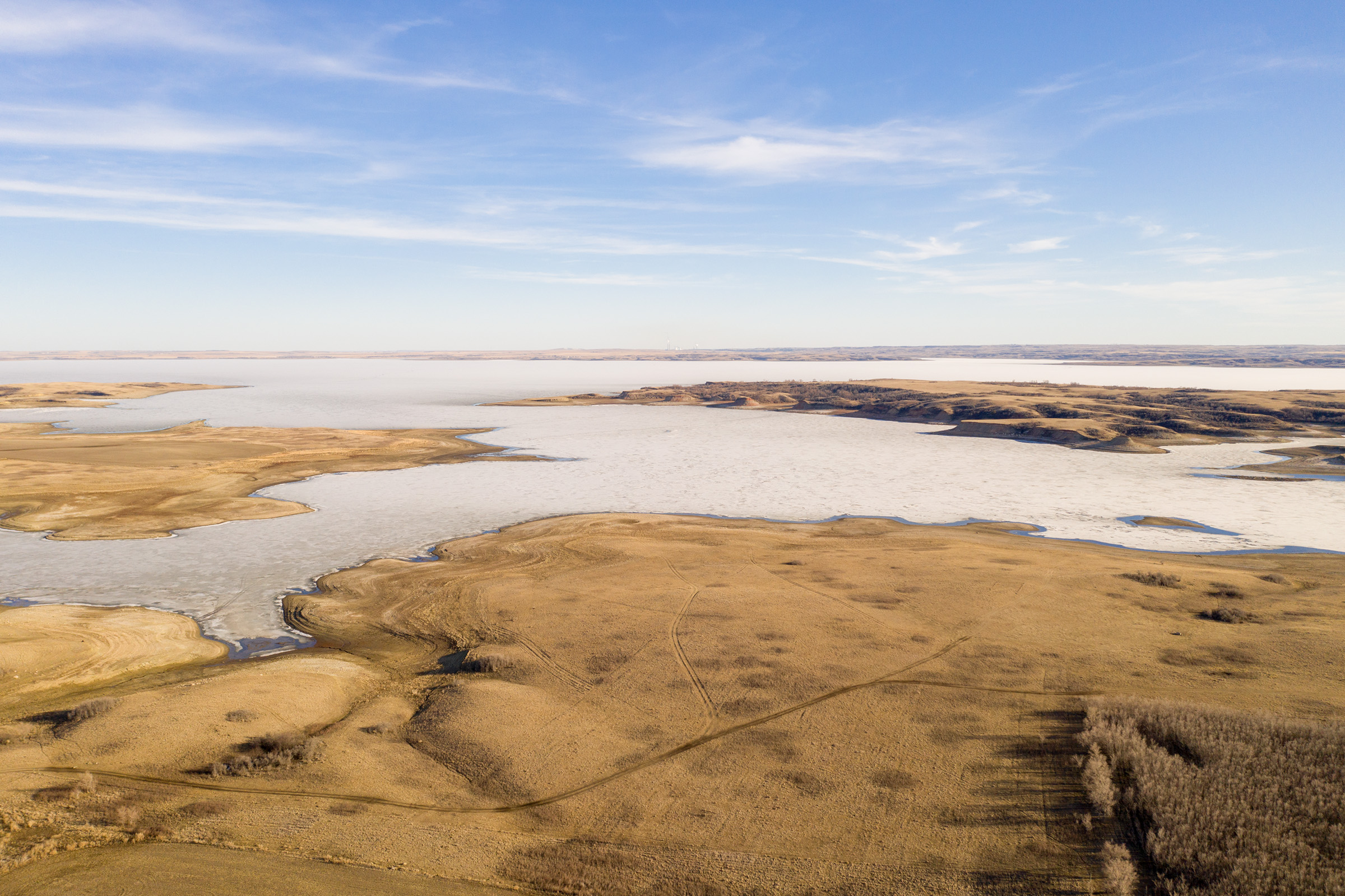
Oil and Water
The Nueta, Hidatsa and Sahnish balance the benefits and drawbacks of fracking
Story by Izaak Opatz, Photos and Video by Richard Forbes
Mandaree, North Dakota, a small town on the Fort Berthold Indian Reservation, has a new indoor trampoline park. Across the street, there’s a new arbor at the powwow grounds. Down the road, a shiny new tanker truck sits inside a trim, fresh-smelling six-bay fire station. And a new dialysis center, a new police station and a new justice center.
None of the buildings are more than 10 years old. All of them have been funded with revenues from oil and gas extraction on Fort Berthold since 2008, and they’re just the most visible examples of a burst of oil-funded investment that includes new water lines, expanded internet access and improved roads throughout the reservation.
But the economic boost of oil boom enjoyed by the Three Affiliated Tribes on Fort Berthold — part of the Bakken oil fields thought to contain up to 7 billion barrels of oil — has come at a cost.
There have been leaking pipelines, fires and trucking accidents that spilled oil and wastewater.
“I saw it firsthand, on the spill sites,” said Edmund Baker, the tribes’ environmental director since 2013. “Smelling the diesel, the chemicals, seeing the death of the vegetation in areas I remember were green growing up.”
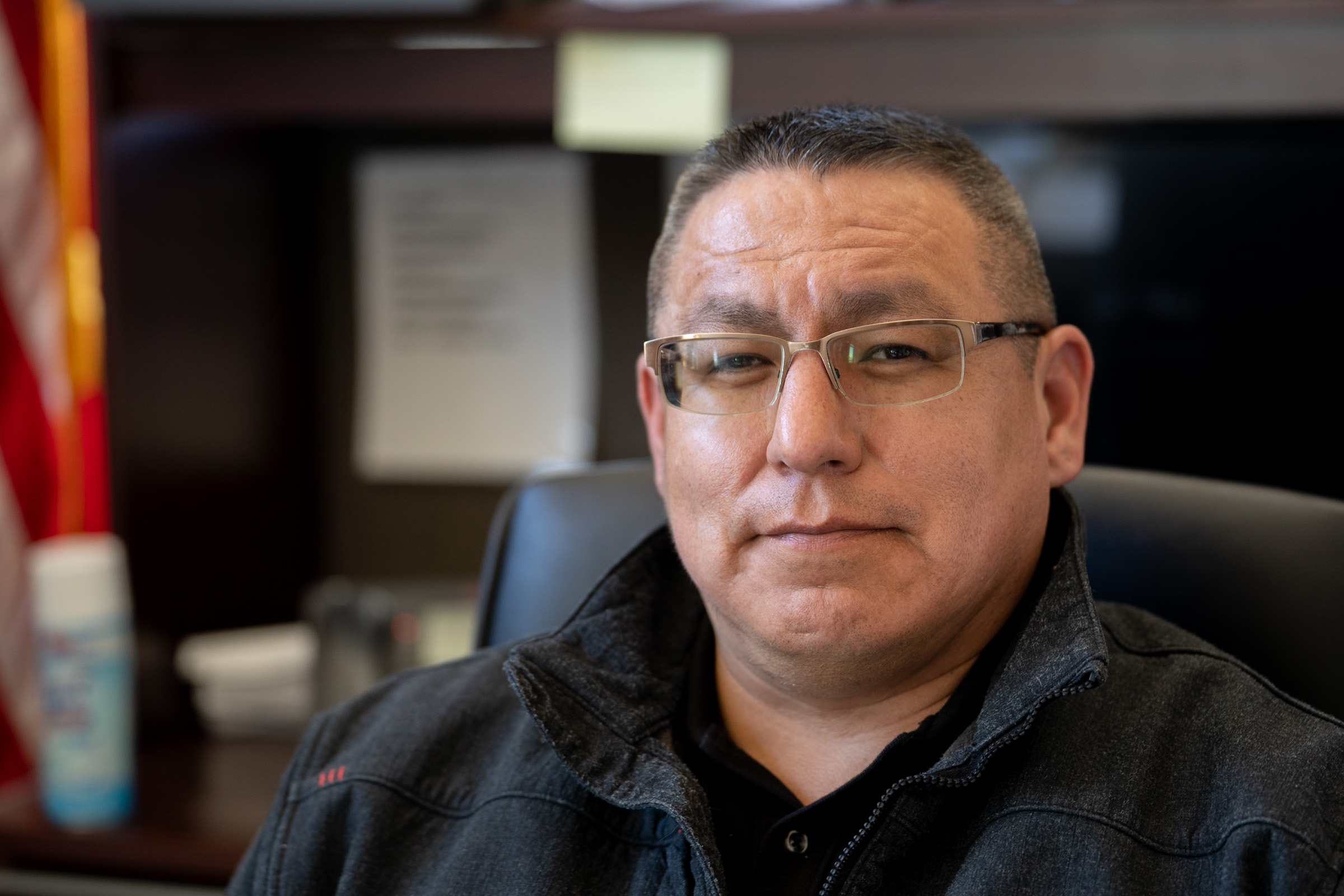
Oil revenues have put money in tribal members’ pockets and paid for a backlog of much-needed social services and infrastructure improvements. Because of this, Baker worries it will be hard for his tribe to disentangle itself from the extraction industry, even as it damages the environment, contributes to climate change and threatens the health and safety of the people living on the reservation.
Sitting behind his desk on the ground floor of the tribes’ new energy complex — five stories of dark glass and smooth stone — Baker gestured around his large office and said, “This building is an example of the oil.”
“What we have done is capitalize on our circumstances,” he said. “But there is a downside.”
Natural gas is flared from a well pad near Mandaree. Flares vary in size and emissions depending on the type of deposit being drilled underground.
When Edmund Baker’s mother was growing up, the Nueta, Hidatsa and Sahnish people tended sunflower orchards, cornfields and bean gardens in the fertile bottomlands along the Missouri River.
These days, the river Baker’s mother remembered is gone. Instead, a 200-mile-long reservoir called Lake Sakakawea covers the homes, schools and gardens that hundreds of families were forced to abandon in 1953 when the Army Corps of Engineers built the Garrison Dam.
The rising waters pushed 80% of the tribe onto the arid benchlands above the new lake, where poor soil, persistent wind and cold weather made survival much more difficult.
“A lot was taken from us quickly as the floodwaters rose,” said Cory Spotted Bear, a member of the Three Affiliated Tribes’ Tribal Business Council.
But the tribes’ fortunes seemed to change in 2008 when high oil prices, new technology and policy changes made an intensive style of mining called fracking suddenly profitable on the reservation. The tribal government at the time embraced the rare opportunity to seize a measure of economic independence, or what the chairman at the time called “sovereignty by the barrel.”
The decision has made the Three Affiliated Tribes, also known as MHA Nation, the country’s top tribal oil producer and addressed some problems even while it created others. But some tribal members question whether the decision was really theirs to make, or if a century of theft, dislocation and forced assimilation by the federal government made it for them.
Spotted Bear asked, “Can you blame an impoverished tribe for trying to finally fix their own roads and fix their own water line and fix their own everything?”
***
Behind Baker’s office, spring ice broke up along the shore of Lake Sakakawea. After two withering summers, it was shrinking in a drought. Baker gestured toward the lake. “This is going to drop another 10 to 15 feet again, according to the Army Corps,” he said. “We’ve never seen this before.”
In May 2021, the tribal business council passed a resolution declaring a drought emergency on the reservation. It stated that drought conditions “created a significant increase in wildfire frequency and size endangering the people, lands, livestock, and wildlife of the MHA Nation.”
But the resolution makes no mention of climate change. The seven-member tribal business council has not addressed the problem directly by drafting a climate change adaptation plan as other tribes have.
Baker said he hasn’t heard the tribal business council talk much about climate change. He thinks tackling the issue is a tough sell for the tribal government while oil and gas revenues are so popular with its constituents.
1. Ice-covered Lake Sakakawea begins to thaw as spring arrives to Nishu Bay near White Shield. Lake Sakakawea was dammed in 1953 against the wishes of the Mandan, Hidatsa, and Arikara tribes and flooded their ancestral homes. 2. Hundreds of well pads dot the reservation. Flaring gas releases methane and other chemicals into the air.
“If you know that there’s an end to your money train, what would you do if you’re coming from poverty?” he asked. “Basically, you’re going, ‘We gotta extract as much as we can out of this.’”
According to Cynthia Monteau, the Three Affiliated Tribes’ tax director, oil and gas mining on the reservation has generated approximately $2 billion in tax revenue since 2008. Some of that money has been used to build new community centers and schools.
In 2014, Chairman Mark Fox established The People’s Fund, an oil-and gas-funded tribal savings ac- count that issues $1,000 checks approximately every four months to each of the Three Affiliated Tribes’ nearly 17,000 members.
In addition, tribal members who lease mineral rights on their allotted land earn a percentage of the value of the oil produced there. These royalties, usually between 15-20%, have made some allottees into millionaires.
Pete Coffey-One Feather, a retired historic preservation officer for the tribe, said he’s “one of the lucky ones.” He earns oil revenues from a piece of land his father owned. He knows some people who earn just $20 per month and others who earn $20,000 per month. He said he’s somewhere in the middle, though he declined to say how much.
He said he had mixed feelings about earning royalties while he was the tribe’s historic preservation officer. Coffey-One Feather was tasked with ensuring that cultural properties were not disturbed by the construction of new roads, pipelines and well pads related to oil and gas drilling.
“But at the same time, I get oil revenues, too, so I always had a conflict within myself,” Coffey-One Feather said. “I didn’t know whether I was part of the problem or not.”
Now, he thinks the tribe should use its money from oil taxes to invest in alternative energies. He’d like to see wind farms and solar arrays in every community on the reservation. “We should be doing stuff like that because they don’t make any more oil,” he said. “Wind is free, sunlight is free.”
Baker, the environmental director, noted that the Three Affiliated Tribes lobbied the Biden Administration last year to not shut down the Dakota Access Pipeline, whose construction was vehemently opposed by the Standing Rock Sioux tribe and others in 2016.


Chairman Fox argued that a shutdown of the pipeline, which would shuttle Bakken crude oil from North Dakota to Illinois, would cost the Three Affiliated Tribes $160 million per year, threaten the environment and increase dangerous truck traffic.
“So that gives you an indication of ‘where does climate change fit?’” Baker said. “When your resources have been dedicated to protecting this flow of prosperity, it just doesn’t really sink in.”
Baker said his people don’t want to suffer like they used to. “I don’t want to see my children in tattered clothes, or go without food for a day, which is how I was raised,” he said.
More than 30% of the reservation lived below the federal poverty level in 2000, according to North Dakota State University data. Today, that number is down to 19%. And compared to other tribes in the state, the Three Affiliated Tribes’ median household income of more than $54,000 tops the list.
“I can’t say 100% where everybody stands,” Baker said, “but I do know one thing for sure: our people have become accustomed to prosperity, become accustomed to the benefits of things we never had before.”
***
Sitting at the front of a classroom at the Nueta Hidatsa Sahnish College in New Town a few miles away, Dr. Kerry Hartman noted that the Three Affiliated Tribes’ history can put climate change in a different light.
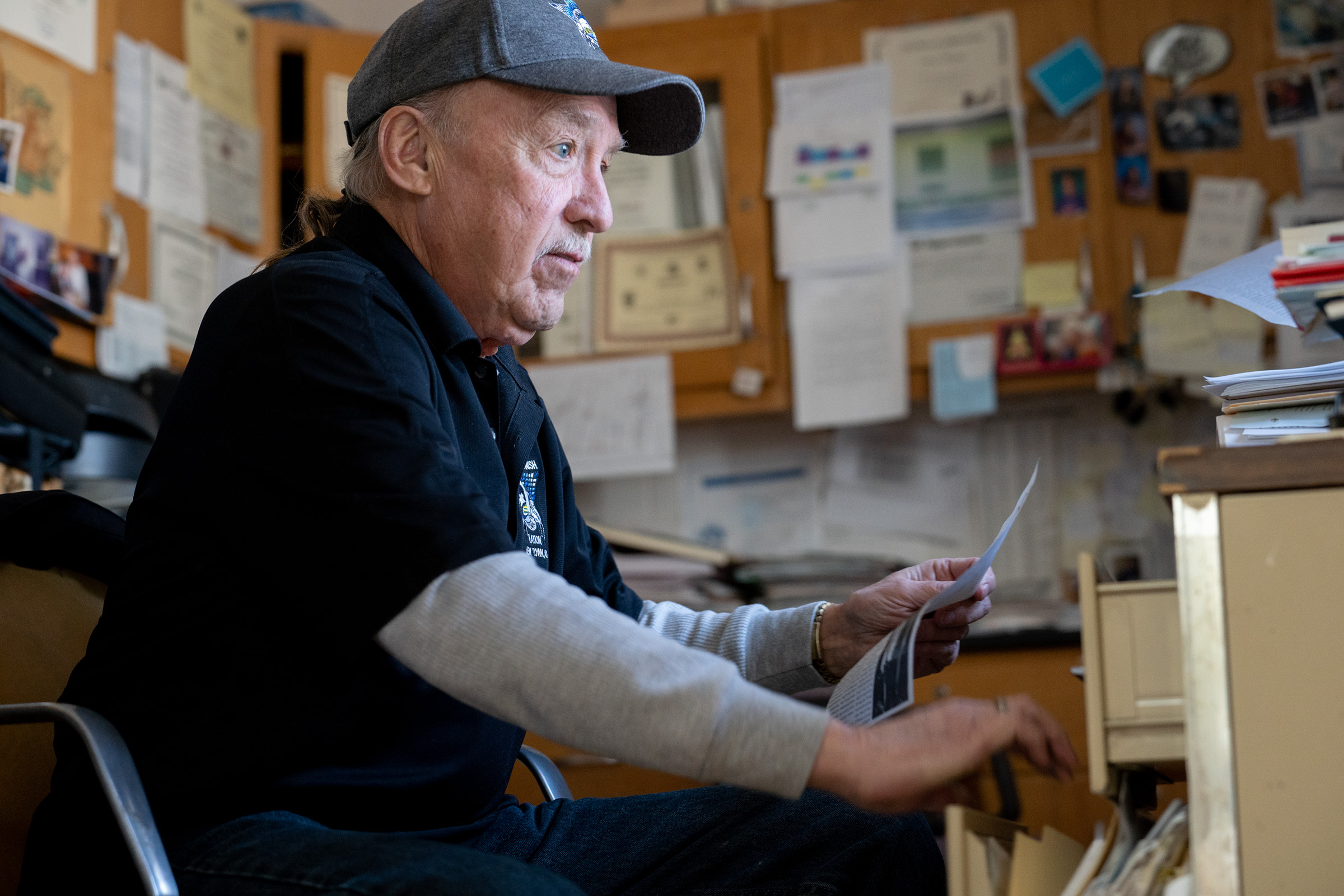
The effects of smallpox epidemics, forced assimilation and displacement from the bottomlands present more immediate challenges in people’s lives, Hartman said. “Climate change is just too big, too long term, too far away, when you’ve got all this kind of stuff, re- cent history, recent trauma, and then very, very recent trauma going on.”
The very, very recent trauma is the boom itself, which brought an increase in violence, drugs and corruption to Fort Berthold, but also polluted its air, land and water. As chair of the environmental science department at Nueta, Hidatsa and Sahnish College, Hartman has led student research testing fracking-affected groundwater, researching the effect of climate change on pollinators and mapping the number and output of flares on the reservation.
But Hartman, who is not a tribal member, said he thinks the tribal business council is too invested in oil extraction to take meaningful notice of its negative impacts.
When his students have shared research with the community or tribal government that implicated fracking, he said, “There was always a lot of, ‘Oh, that’s terrible. We should do something about that. But we need the money, so we need the oil, so we’re going to keep doing what we’re doing.’”
***
Lisa DeVille, an environmental activist on Fort Berthold and former student of Hartman’s, will admit she has seen the benefits of oil and gas extraction. She and her husband, Walter, both worked while raising five children in Mandaree. Today they live off of the oil and gas revenues that Walter earns as the partial owner of a piece of leased land.
Walter never would have signed the lease to allow drilling on his land, Lisa said, but he didn’t have a choice. Only a simple majority is required of the sometimes hundreds of allottees who may share ownership of a single piece of land. In Walter’s case, a majority opted to lease the land’s mineral rights before anybody asked him.
The DeVilles live in a comfortable one-story home in Mandaree. Deep leather sofas with built-in cup- holders face a large flat-screen television in a living room adorned with Green Bay Packers insignia. Lisa declined to specify how much they earn from royalties each month. “It gets us by, I’ll say that,” she said.
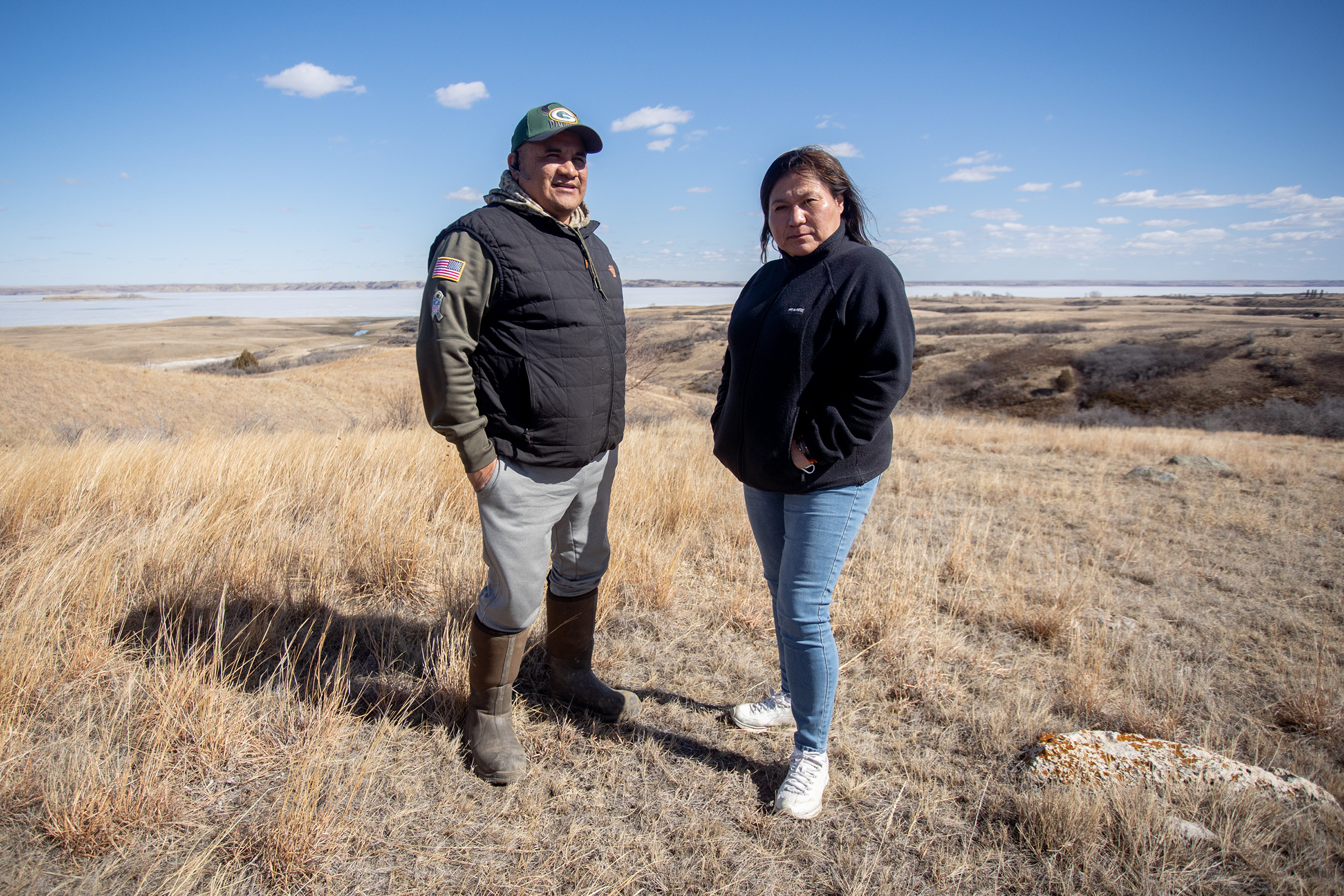
Whatever the amount, it has freed her to be a full-time activist. She is frequently critical of the oil industry, but does not see earning oil money as a contradiction.
“It’s not something that I wrestle with because what we fight for are stronger regulations,” Lisa said. “We want it done the right way.”
In 2010, she co-founded Fort Berthold Protectors of Water and Earth Rights, or POWER, to muster opposition to what she saw as an industry out of control. Especially in the Mandaree area, which saw the bulk of new wells, the sudden boom brought a flood of heavy truck traffic, oilfield trash and a scourge of crime.
Lisa began to feel like her community was getting the short end of the stick. “Yeah, oil revenue is helping with all this stuff,” she said, “but why are we not holding industry accountable for what’s happening?”
She began to call her representative on the tribal business council to ask what they were doing to protect her community. She went door to door with a 75-question survey, asking her neighbors what they thought about the oil and gas industry’s effect on their health, the community and the environment.
DeVille said the vast majority of her neighbors indicated that they wanted their tribal government to regulate the oil and gas industry more.
Again and again, she asked the tribal business council, “Why is it that we didn’t have a plan?”
***
A small beaded pouch swung from Walter’s rearview mirror as his truck rumbled down a bumpy red dirt road through the benchlands above Lake Saka- kawea. In the passenger seat, Lisa talked hurriedly, running through a litany of standoffs with her tribal business council. She spoke openly and passionately but had clearly given this spiel before.
Today, Lisa acts as an ambassador to scientists, journalists and nonprofits who want to look more deeply into the fracking boom on Fort Berthold. The DeVilles lead what they call the ‘toxic tour,’ a five-hour saga in Walter’s Dodge Ram around the Mandaree area’s seemingly endless dirt roads, visiting spill sites and other areas impacted by fracking.
At the end of one dirt road, Walter parked the truck at the top of a small coulee that drains into the lake’s Bear Den Bay. He and Lisa hiked down the steep slope, slipping on the mud and dry grass, before stopping in front of a small pond where the water was stained a deep ochre.
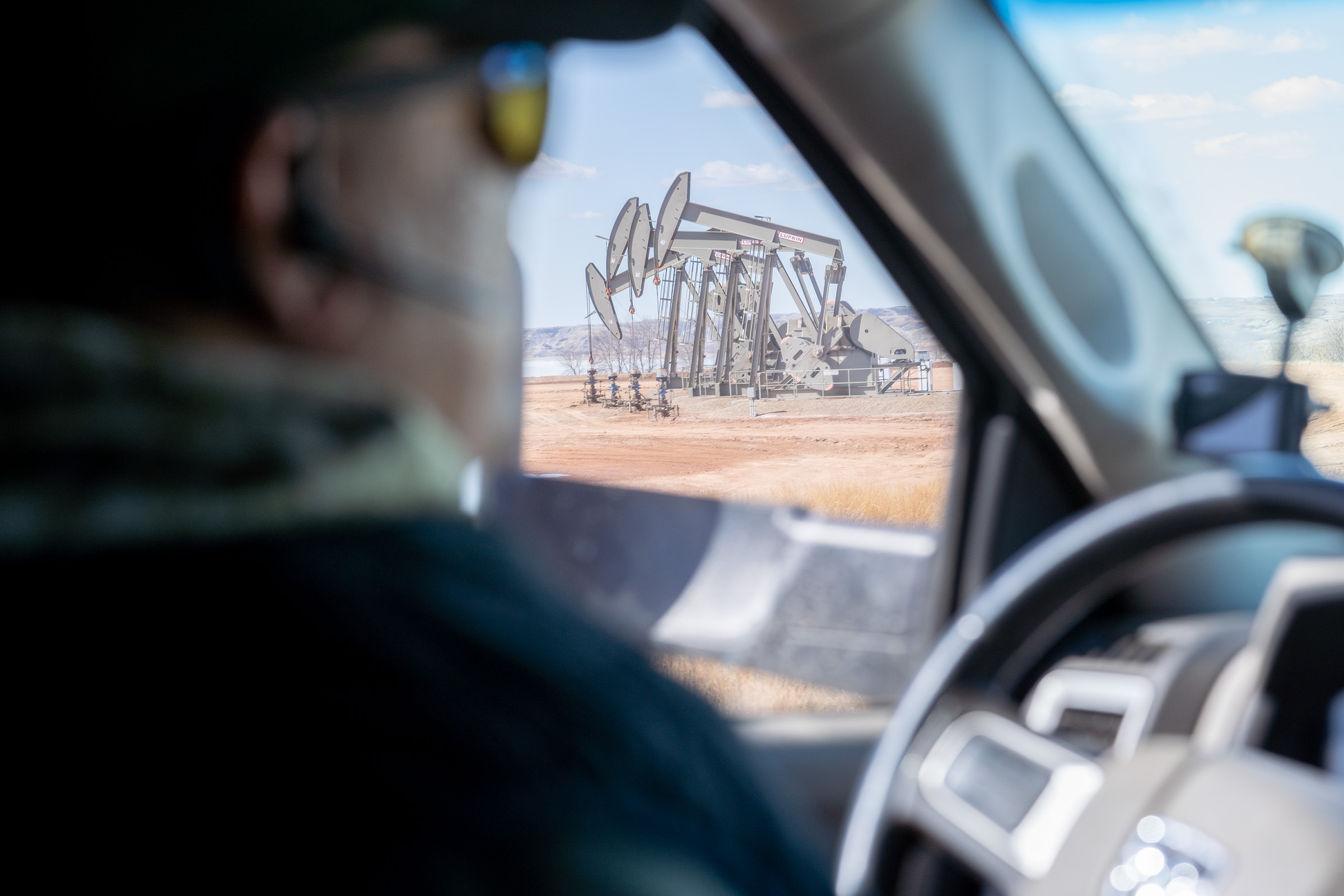
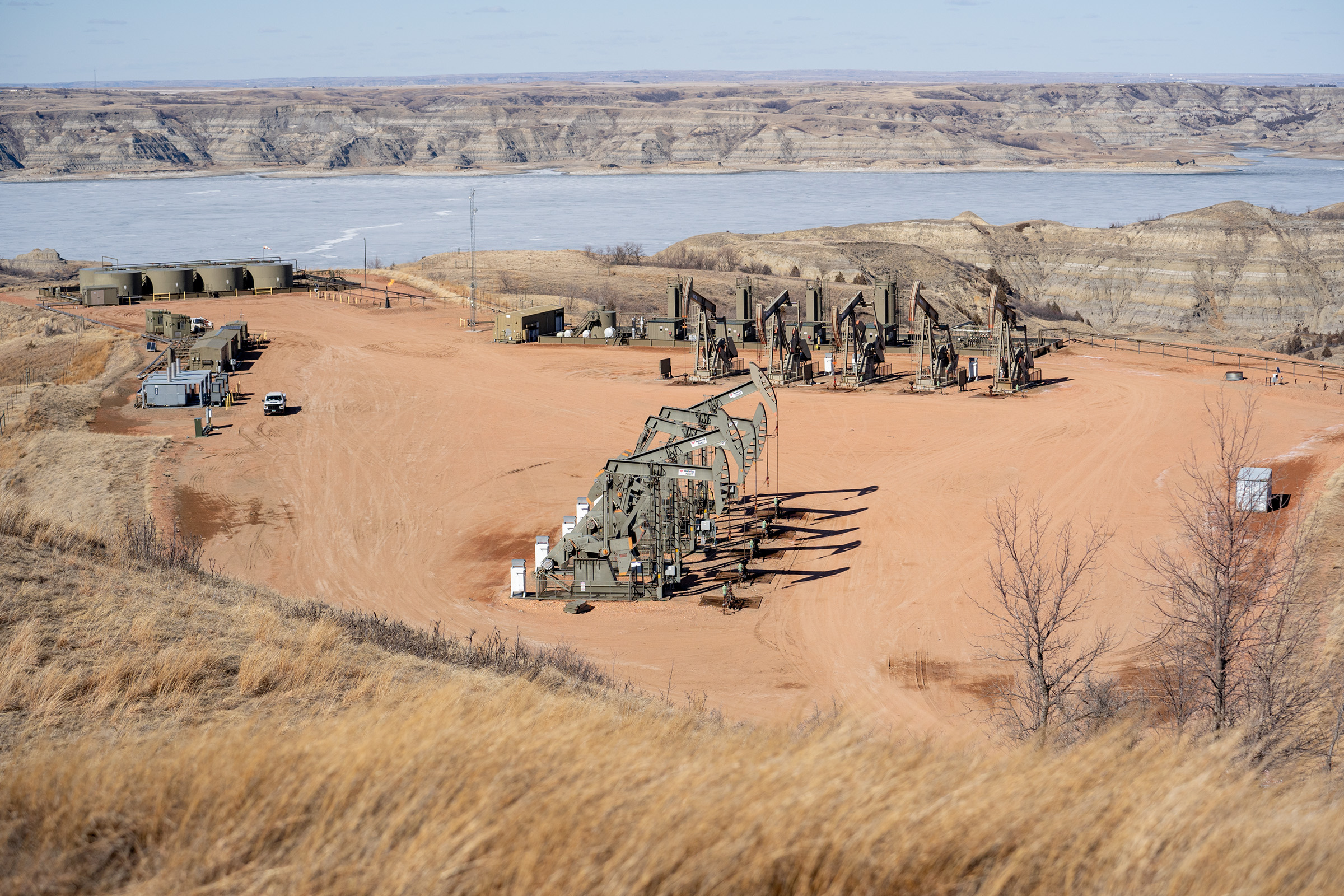


A broken wastewater pipeline up the hill spilled a million gallons of brine at this site in 2014. The DeVilles later brought researchers from Duke University here. The scientists found that wastewater made its way into Lake Sakakawea just a quarter mile from where an intake pipe collects drinking water.
“Nobody knew what brine was,” Lisa said. She looked it up and posted what she found to Facebook. It wasn’t the first time she had been forced to find out for herself the costs that came with living in an oil patch. She’s disappointed that her tribal business council didn’t take the time at the beginning of the boom to fully explain the risks that came with fracking.
“They’re not educating our people,” Lisa said of her tribe’s leaders. “The tribal council’s not sitting there saying, ‘Come, let me tell you what fracking’s all about and what the truth is about what kind of contaminations are happening.’ That’s not happening.”
This spring, Lisa will be on the ballot to represent North Dakota’s State House District 4a, a new legislative district covering Fort Berthold. If elected, she said, she’ll keep asking questions.
***
Outside the Mandaree community center, a stiff wind raked across the clay buttes in the distance and flipped Spotted Bear’s hat across the parking lot. Flames on distant flare stacks whipped and guttered, driven nearly horizontal by the strong gusts.
He was in Mandaree to hear his colleague pitch the idea of a geothermal power plant for her community. It would be another multi-million dollar project, but one that reflected Spotted Bear’s vision for Twin Buttes, “to take the finite resource – oil, gas – and reinvest it into the perpetual, as a cultural model.”
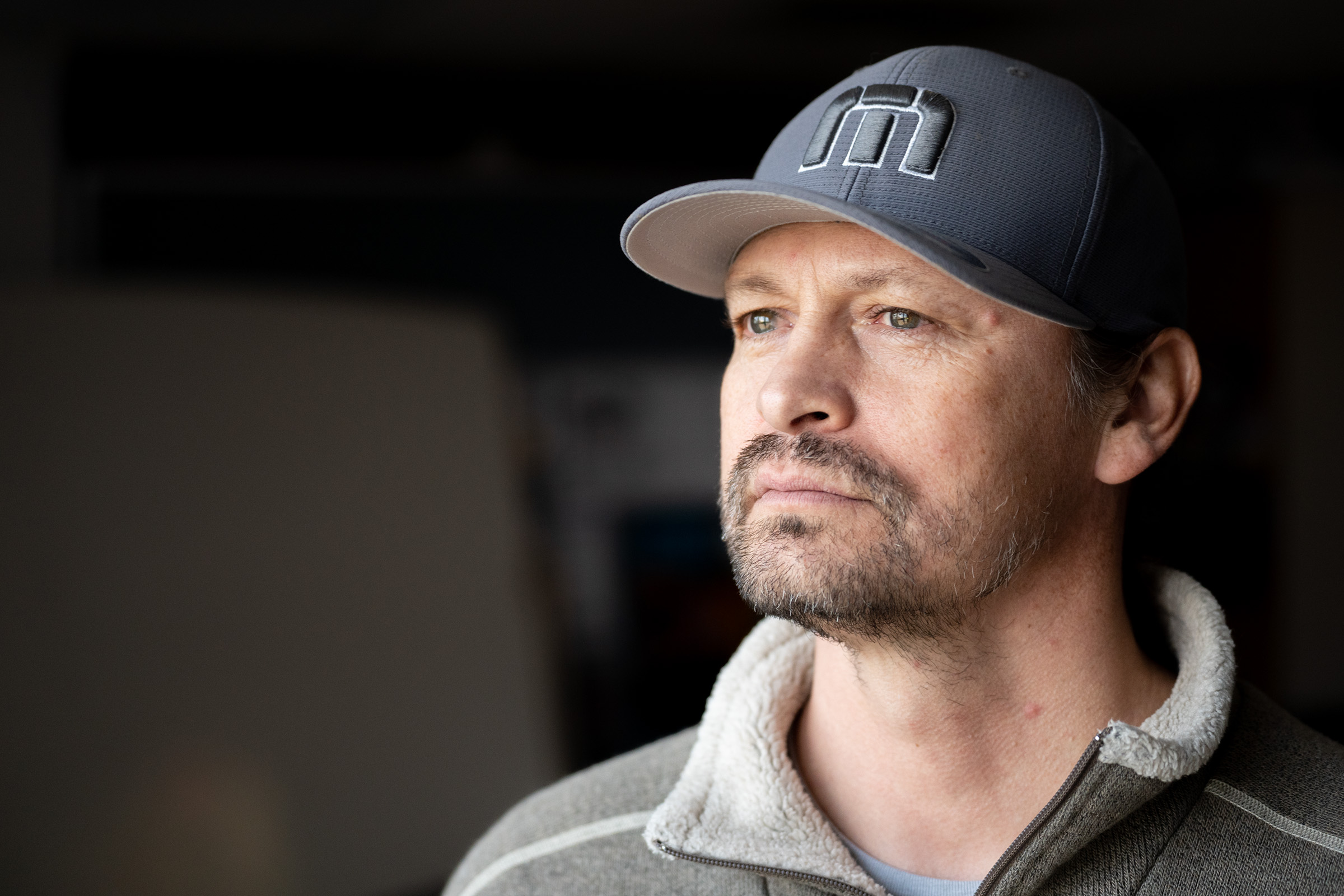
Investing in what’s left of his tribes’ culture is what drew Spotted Bear into politics in the first place. After college, he started the Nu’eta Language Initiative to help save the Nu’eta language. At that time, an elder named Edwin Benson was the language’s last native speaker. Spotted Bear ran for his council seat in part to secure oil and gas revenues to fund a desperate effort to record as much of the language as possible before Benson died in 2016.
He said he’s spread thin just responding to the basic needs of community members who, like himself, don’t earn a dime from oil and gas leasing. He noted that 40 community members in Twin Buttes were still hauling water by hand from a water pump to their houses until four years ago, when he helped connect them to the tribal water system.
“We’re trying to keep our heads above water, we’re trying to survive and carry on,” he said. But Spotted Bear also insists on looking beyond the boom, to continue investing in a more sustainable future.
1. Four Bears Bridge, built in 2005, spans Lake Sakakawea, a reservoir created in 1953 against the wishes of the Three Affiliated Tribes. The new bridge, which had a $54 million price tag, replaced a much narrower bridge and enabled oil and gas tankers to travel across the reservation. 2. A tractor-trailer drives Highway 22 near Mandaree. Oil and gas development on the reservation has led to dramatic increases in heavy truck traffic that wears down tribal roadways, requiring continual reinvestment of oil and gas royalties. To handle the heavy loads, roads must be rebuilt, costing up to $4 million per mile, according to MHA Nation Vice-Chairman Cory Spotted Bear. 3. Flares light up the night sky across Fort Berthold Reservation, obscuring the stars.
In that spirit, he’s invested in energy-efficient geothermal heat pumps to heat and cool Twin Buttes’ new community center and store. Twin Buttes has its own bison and elk herds, keeps honeybees, a community garden and a juneberry orchard, all foods he said are a “cultural match” for the Nueta people.
Next, Spotted Bear dreams of building a micro-grid for the community that can store and distribute power from wind, solar and geothermal sources. It exemplifies the kind of pivot he thinks the Three Affiliated Tribes will need to make in coming years, from relying on oil and gas extraction to harnessing sustainable energy.
“It’s protecting our sovereignty, self-reliance,” he said. “And it’s the right thing to do.”
Spotted Bear realizes that the oil and gas won’t be around forever. Whether the oil boom has been a boon or a bust for the Three Affiliated Tribes depends on what they decide to do next.
“It’s kind of a touchy deal where we’re labeled as an oil and gas tribe,” he said, “but some of us are trying to change that narrative, we’re trying to go in a different direction.”
A SPECIAL PROJECT BY THE UNIVERSITY OF MONTANA SCHOOL OF JOURNALISM
ADDITIONAL FUNDING SUPPORT FROM THE GREATER MONTANA FOUNDATION
READ MORE:
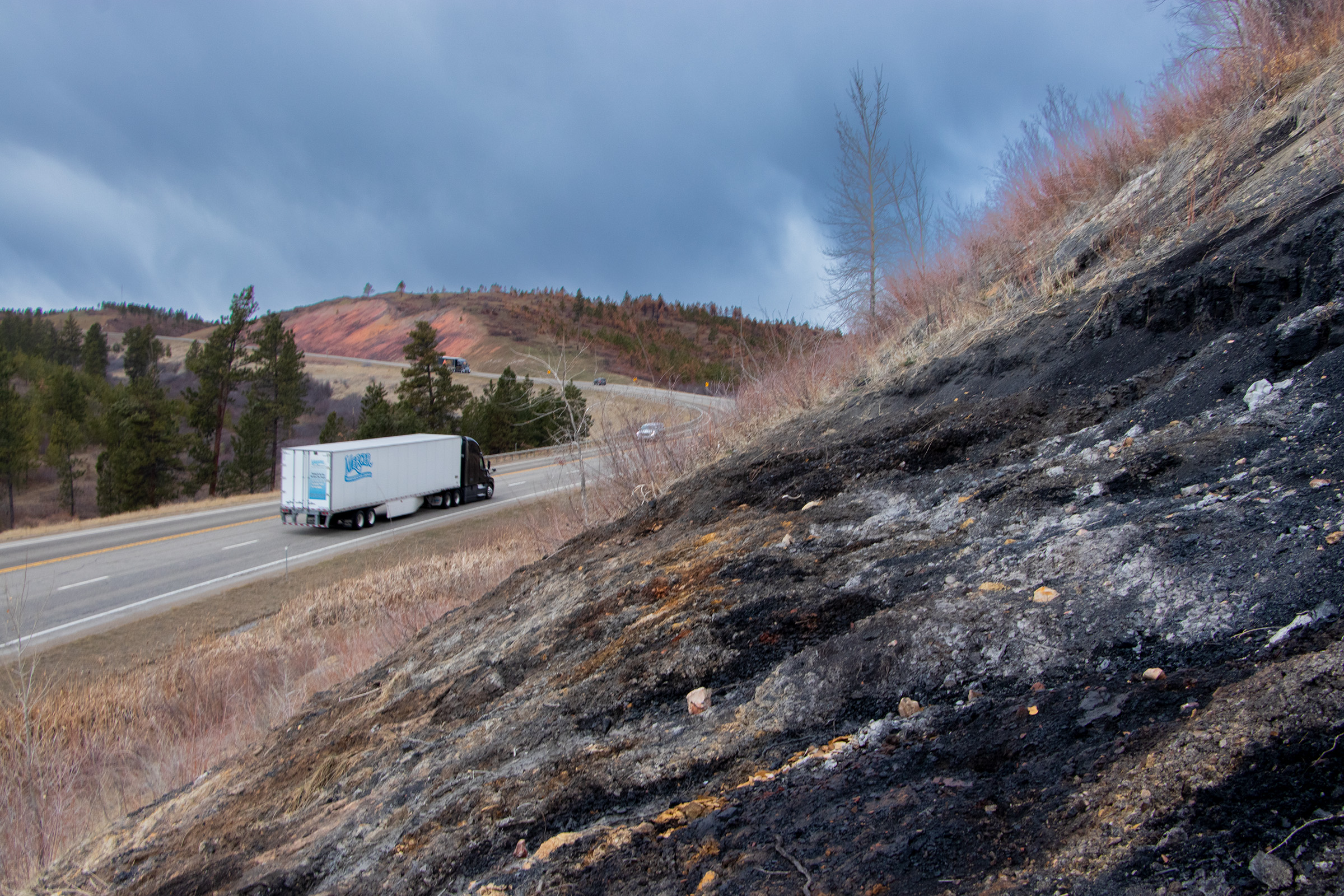
Previous